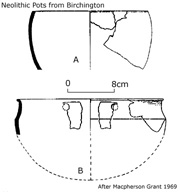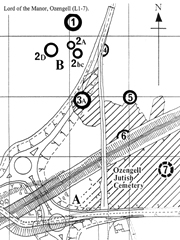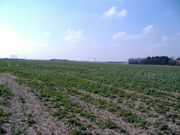
Return to Neolithic Gallery introduction
Display Contents
Neolithic Thanet
by Nigel Macpherson Grant
The former Isle of Thanet was settled from the continent from the beginning of the Neolithic period onwards.
The combination of warm brickearth sub-soils and underlying well drained chalk rock that form the geological structure of the island produced ideal arable and grazing land encouraging the development of fairly substantial settlements.

Finds of Early Neolithic pottery and
flint knapping locations from the buried
land surface off the shore at Minnis Bay and off mainland Whitstable
confirm that these coastal zones were habitable between circa 4000-3400 BC
for as much as 1 mile beyond the present shoreline.
Traces of early activity on the island’s southern east-west upland spine are represented by a small settlement enclosure at Minster and burials from Nethercourt near Ramsgate and on the chalk ridge above Monkton.
Traces of early activity on the island’s southern east-west upland spine are represented by a small settlement enclosure at Minster and burials from Nethercourt near Ramsgate and on the chalk ridge above Monkton.
The recording in 1997 of the settlement
at Chilton, in the south-east of the island overlooking Pegwell Bay,
proved that Thanet and mainland Kent witnessed the same Earlier
Neolithic cultural tradition of the construction of large multi-ditched
Causewayed Enclosures that have parallels on the continent and
elsewhere in southern and eastern England.

The ring-ditch and roundbarrow monuments
at Lord of the Manor
(Thanet Archaeological Unit)

The fields at Lord of the Manor today
Early settlement was not just confined
to chalk downland or the accessible coastal island margins. Traces of a
slightly later enclosure on inland plateau brickearth soils near
Manston and the finds of polished flint axes and Neolithic arrowheads
and tools across the island demonstrate widespread settlement.
Continuity of relatively intense settlement activity is represented by Middle Neolithic pottery and flintwork from the Chilton Pegwell Bay area, Margate, Brooks End and Minnis Bay in the western part of the island.
By the Later Neolithic (from circa 3000 BC onwards) settlement and land-clearance for farming and sheep grazing had, almost certainly reduced the degree of natural forest cover and created great swathes of open uplands as it had elsewhere on southern English downlands.
Just as at the larger centres of Stonehenge and Avebury in Wiltshire and Thornton in Yorkshire and elsewhere, at least 6 circular ceremonial enclosures – albeit at a smaller scale – were built in the south-east part of the island, on the chalk downland around present-day Lord-of-the-Manor, overlooking Pegwell Bay. At least one of these had a sacrificial offering of a girl’s skull with a boar’s rib placed through the foramen magnum at the back of her head.
Continuity of relatively intense settlement activity is represented by Middle Neolithic pottery and flintwork from the Chilton Pegwell Bay area, Margate, Brooks End and Minnis Bay in the western part of the island.
By the Later Neolithic (from circa 3000 BC onwards) settlement and land-clearance for farming and sheep grazing had, almost certainly reduced the degree of natural forest cover and created great swathes of open uplands as it had elsewhere on southern English downlands.
Just as at the larger centres of Stonehenge and Avebury in Wiltshire and Thornton in Yorkshire and elsewhere, at least 6 circular ceremonial enclosures – albeit at a smaller scale – were built in the south-east part of the island, on the chalk downland around present-day Lord-of-the-Manor, overlooking Pegwell Bay. At least one of these had a sacrificial offering of a girl’s skull with a boar’s rib placed through the foramen magnum at the back of her head.
Thanks to the webmeister Ges Moody for the reproduction of Nigel Macpherson Grant's illustration of the Minnis Bay vessels.
Version 1 - Posted 06.03.05
Version 2 - Posted 12.04.06
Version 3 - Posted 16.12.06
All
content © Trust for Thanet Archaeology